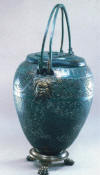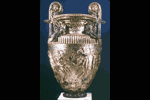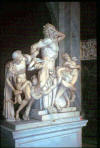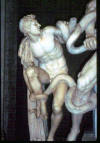Alexander's Crown

A Bronze Lantern

A Pair of Gold Earrings

A Golden Krater **

A Golden Quivver for Arrows

Library at Ephesus (Efes,
Turkey)
 (Photo credit: R. Borneman,
2000)
(Photo credit: R. Borneman,
2000)
"In
the opening years of the second century B.C., the Roman
general Flaminius defeated the Macedonian army and declared
the old poleis of Classical Greece as free once again.
They never, however, regained their former glory.
Athens, for example, sided with king Mithridates VI of
Pontus (r. 120 - 63 B.C.) in his war against Rome and was
crushed by the general Sulla in 86 B.C. Thereafter, it
retained some of its earlier prestige as a center of culture
and learning, but politically Athens was just another city
incorporated into the ever-expanding
Roman Empire.
Greek artists, however, continued to be in great demand, not
only to furnish the Romans with an endless stream of copies
of Classical and Hellenistic masterpieces but also to create
new statues a la grecque for Roman patrons.
One
such work is the famous group of the Trojan priest Laocoon
and his sons, which was discovered in Rome in 1506 in the
presence of the great Italian Renaissance Artist
Michelangelo.
The marble group, long believed to be an original of the
second century B.C., was found in the remains of the emperor
Titus' (r. 79 - 81) palace, exactly where Pliny had seen it
more than fourteen centuries before. Pliny attributed
the statue to three Rhodian sculptors - Athanadoros,
Hagesandros, and Polydoros - who are now generally thought
to have worked in the early first century A.D. They
probably based their work on a Hellenistic masterpiece
depicting Laocoon and only one son. Their variation on
the original [adds the other son in order to] conform with
the Roman poet Vergil's account in the Aeneid.
Vergil vividly described the strangling of Laocoon and his
two sons by sea serpents while sacrificing at an
altar. The gods who had favored the Greeks in the war
against Troy had sent the serpents to punish Laocoon, who
had tried to warn his compatriots about the danger of
bringing the Greek's Wooden Horse within the walls of their
city."
- Gardner's
Art Through The Ages,
11th edition, Vol. I, pp. 157 - 158
Laocoon

"In Vergil's graphic
account, Laocoon suffered in terrible agony, and the torment
of the priest and his sons is communicated in a spectacular
fashion in the marble group. The three writhe in pain
as they struggle to free themselves from the death grip of
the serpents. One bites into Laocoon's ... hip as the
priest lets out a ferocious cry."
- Gardner's
Art Through The Ages,
11th edition, Vol. I, p. 158
Laocoon (detail)

|